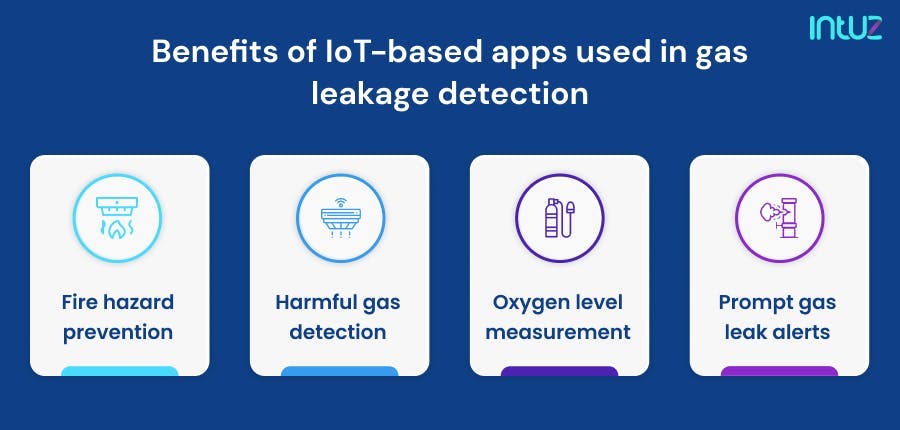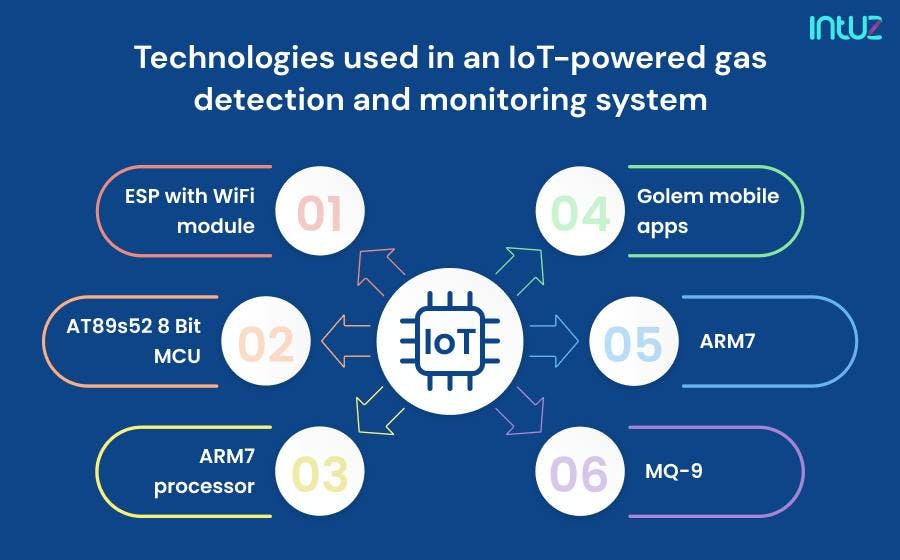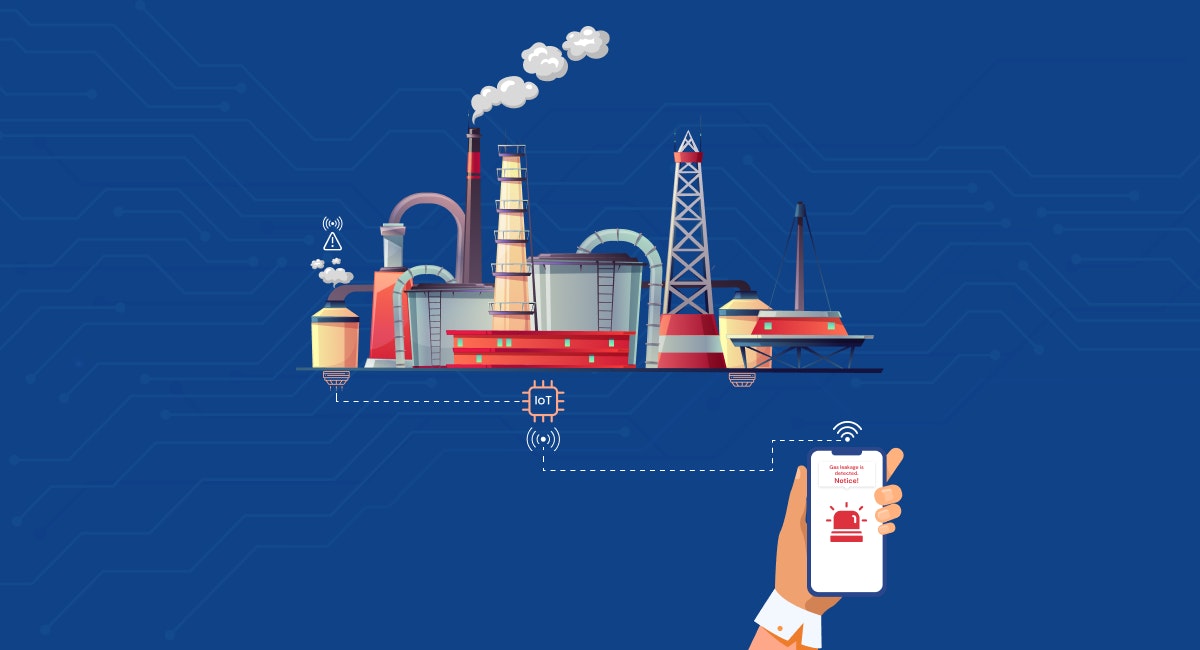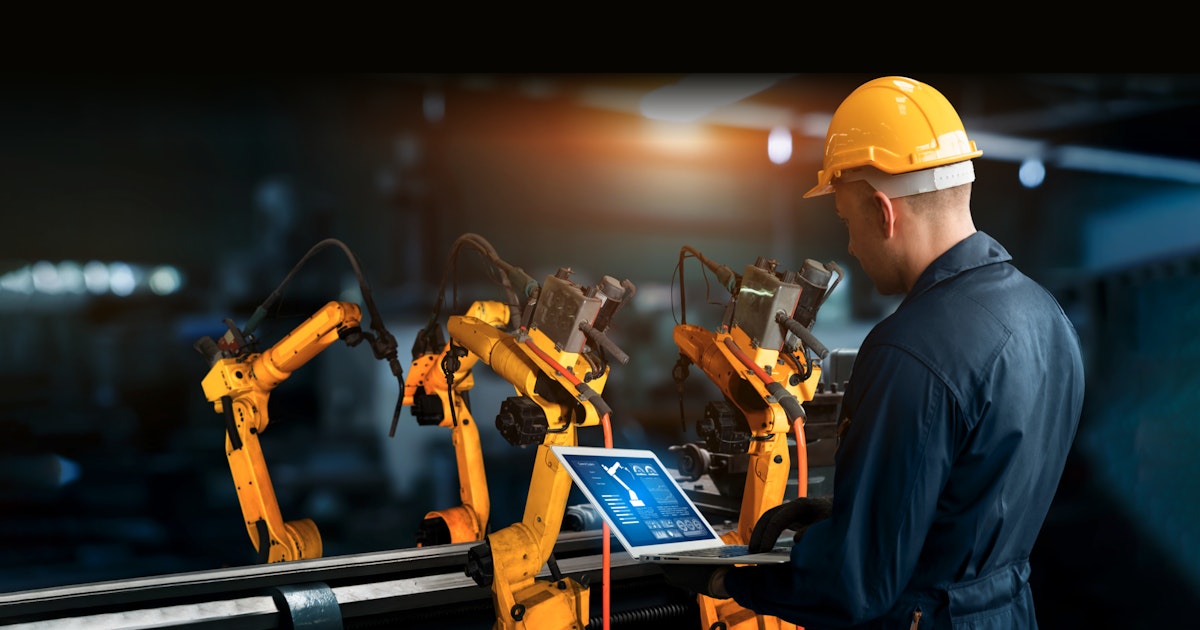Safety plays a critical role in today’s world and it is vital that certain solutions are implemented in places of work and living. Whether it is electricity or oil and gas, working or living in hazardous conditions demand certain safety protocols.
Liquified Petroleum Gas (LPG) is a type of natural gas liquified under extreme pressure and contained in a metal cylinder. LPG is extremely sensitive to fire and causes a great disaster if exposed to any fire source without precaution.
LPG is more widely available than any other natural gas and is primarily used for cooking. Unfortunately, its broad use makes the event of gas leakage or even a blast standard. Therefore, there is a need to develop a gas leakage detection and monitoring system.
The solution could detect gas leakage, send an alert to the end-user via an SMS or a buzzer, and feature an exhaust fan that gets activated once the gas or fire is detected. The fan aims to push the air outside.
In another scenario, we could use a load cell sensor to monitor the weight of the LPG gas cylinder regularly and feed the values to the microcontroller.
Suppose the gas in the cylinder indicates a value where the remaining percentage level falls below the threshold level set for gas. In that case, the gas cylinder company should be notified immediately to refill the cylinder or replace it. The sensor is also handy for monitoring gas usage over a period.
Introduction Internet of Things (IoT) in gas leakage detector
IoT refers to the network of physical objects or “things” that communicate with each other with the help of IoT sensors, modules, software, and other technologies and exchange data with other devices and systems over the internet.
IoT applications range from sophisticated industrial tools to ordinary household objects. As of today, there are more than seven billion connected IoT devices worldwide, and the number is expected to grow by 22 billion by 2025.
It is no surprise that IoT has become one of the most critical technologies to be conceived in the 21st century in the past few years. Who would have thought about switching on the fan using a smartphone - while sitting at opposite ends of the house?
Connecting everyday objects such as cars, baby monitors, thermostats, and kitchen appliances to the internet through embedded devices makes seamless communication possible between things, processes, and people!
Employing low-cost computing, the cloud, big data analytics, and mobile technologies, physical “things” can exchange data without any human interaction. Hence, IoT apps are an apt choice in the case of gas detection and monitoring.
So, how will IoT come in handy for the same? Does it offer the perfect solution for keeping gas leakage in check? Yes, it does, and in ways you cannot even imagine! Let us find out:
Let's Develop Your IoT Gas Detection System!
Explore SolutionsIoT oil and gas: An overview
The world is moving at a rapid pace. The pandemic is long behind us, and businesses across domains are gearing up to catch up with the two years they lost due to the Coronavirus outbreak. Now is the time to embrace excellence and reduce unnecessary expenses with scalable IoT solutions - and this also holds true for the oil and gas domain.
Various commercial companies such as hotels and takeaway joints utilize flammable gasses - for instance, carbon dioxide, LPG, ammonia, and so on - to deliver the best customer service possible. The use of such gasses cannot be denied.
However, they have also brought about a greater risk and threat to human life. With safety a primary concern, businesses dealing with gas have to take certain precautions to ensure work is carried out in the most secure manner possible.
That is where a gas detection system is necessary at accident-prone locations, including households, to continuously monitor any kind of leakage - regardless of the human senses - and send an alert to the end-user.
The gasses are toxic in nature, resulting in human unconsciousness and even death if consumed in larger quantities. Moreover, gaseous blasts are another disaster that everyone - working in a factory or at home - would want to avoid at all costs!
Using an Ethernet shield module and Android application, the IoT device informs the end-user about the environmental conditions, such as the temperature of the location and gas level. The gas detection system monitors the surroundings continuously and prevents further gas leakage.
The IoT-powered gas leakage detection utilizes an MQ6 sensor for the same. It detects the malfunctioning of the pressurized gas system to prevent the accumulation of gasses so that the explosion does not happen.
The system is divided into three modules:
- Firstly, the MQ6 gas sensors detect gas leakage.
- Secondly, the signals are sent to the ARM through the IoT sensors. Post this, an activation ping gets sent to the devices connected externally with the help of a microcontroller.
- Lastly, various functions by devices such as exhaust fan, buzzer, and sprinkler are performed, further activating the GSM module.
The GSM module and the ARM-based microcontroller use gas detection for communicating amongst devices. In addition, Arduino, a low-cost microcontroller, is engineered in such a way it receives the input data from the sensors. For ensuring regular communication between Arduino and the smartphone, Bluetooth is required.
IoT Hardware Platforms Of 2022: What To Consider
Explore NowThe scope of growth of IoT and Arduino-based LPG leakage detection system
The said system can be deployed in homes, hotels, factory units, LPG cylinder storage areas, and so on. The main advantage of this IoT and Arduino-based application is that it can determine the leakage and send the data over to a site. It can be monitored, and preventive measures can be taken to avoid any disaster.
Suppose corrective steps are taken promptly after it is reported over the IoT devices. In that case, that can help save the loss of lives, alleviate any mishaps from happening, and cut down on business expenses.
The gas leakage detection system can be optimized for detecting toxic gasses along with upgrading them with smoke and fire detectors to identify the presence of smoke and fire. Ensuring worker safety is important but making using of the right technology is even more vital.
Benefits of IoT-based apps used in gas leakage detection
A human nose comprises 400 different types of scent receptors that enable us to smell approximately 1 trillion various odors. However, most of us cannot identify between the different gasses present in the atmosphere. That is where gas detection sensors come in handy.
They are most commonly used to develop an IoT-powered system and identify the variation of toxic gasses in an industrial facility. It helps benefit the refineries and factories by safeguarding them from unexpected threats such as gas leakage and explosions. Here are the top benefits of IoT-based apps used in gas leakage detection.

1. Fire hazard prevention
The gas sensors monitor the concentration of the gasses present in the atmosphere to avoid disasters such as fire breakouts and explosions. It is also essential to keep the machinery and factory workers safe from fire hazards or gas leakage.
The IoT-based devices detect the presence of gasses such as methane and propane and notify the authorities in time for preventive measures to be taken. The gas leakage detection system comprises gas analyzers for generating alerts regarding the temperature increase.
This allows the management to take immediate measures to eliminate harmful (and even fatal) fire blasts, save lives and cut down on unnecessary business expenses.
2. Harmful gas detection
Keeping the levels of methane, hydrogen sulfide and carbon monoxide in check is essential in any commercial or personal territory to avoid poisonous gas leaks and blasts. IoT-based applications can easily detect the presence of such gasses anywhere they are installed. The sensor-enabled solution reduces the risk of gas explosions and any casualties inside or outside the main premises. IoT application development for gas detection is helpful!
3. Oxygen level measurement
Us humans need oxygen to breathe, and the lack of it can be a cause of concern during mining explorations. Let us not forget that there is always the risk of poisonous gas leaks when mining at gross underground levels.
A sudden slip in oxygen levels can lead to brain damage, dizziness, and even death. That is why industrial businesses - whether mines or close-packed premises - have to maintain optimal oxygen levels for the safety of their workers.
An IoT-based gas detection system helps keep the oxygen presence in check and alerts the authorities in time to take measures in case the levels go down.
4. Prompt gas leak alerts
IoT networks are known for their low power transmission and low energy consumption. This enables the assets to operate for a longer duration and produce more accurate data.
An IoT-equipped gas monitoring solution works via sensors, providing data regarding the presence of any poisonous gasses. If that is the case, then the system pings the authorities.
You can successfully measure humidity and temperature in the atmosphere, resulting in optimal factory facilities and ensuring worker safety.
Technologies used in an IoT-powered gas detection and monitoring system
Detecting gasses is necessary regardless of your business role or individual purpose. Certain technologies at play make such IoT devices what they are, and if you want to indulge in IoT application development, you must know what they are and what purpose they can fulfill. Here are the top eight technologies in use:

1. ESP with WiFi module
This detects the flow and depletion of gas by using the MQ-2, GP2D129 sensor. For measurement purposes, they use a load cell sensor that helps identify the gas level in the cylinder and alerts the end-user using a buzzer if there is an anomaly.
2. AT89s52 8 Bit MCU
This system uses two sensors - gas and temperature - to keep the gas levels in check and monitor the temperature in an area accurately. This also has a buzzer, which will start buzzing if there is a leakage or fire. An LCD screen will show the status of the environment.
3. ARM7 processor
The system detects the load cell sensor for measuring the gas present in the cylinder. For instance, if the load is lower than 2kgs, the authorized party will automatically get notified via connected devices on the provided number if it is a smartphone.
4. Golem mobile apps
In 2014, a new system was introduced called, Golem, which is a decentralized marketplace for computing power. In this solution, the characteristics are heavily indisputable, and they come in handy for conducting a series of tests.
Various systems such as the complementary detector system, navigation system, and a drive unit are achieved significantly throughout the tests.
5. MQ-9
This is another solution introduced with the help of embedded systems called MQ-9 computer circuits. The system typically activates a buzzer, after which the semiconductor diode is alarmed with such an event of gas.
6. ARM7
This machine-driven and high-performance system work by detecting LPG leakage in an environment. It takes the help of a microcontroller, which sends messages or emergency alerts. The system then detects the authorized party through an SMS. The system also gives the former the ability to shut down the system in addition to activating the alarm.
Are You Ready to Protect Your Facility with IoT-Enabled Smart Gas Monitoring?
Let's get StartedOver to you
The IoT gas leakage detection system is a boon as it saves lives, keeps expenses in check, and helps businesses conduct their operations in compliance with the law. The system alerts notifications to the end-user - who responds accordingly with the help of connected devices such as a smartphone on the go.
Whether you own a factory or are in charge of a commercial building, you need to keep the gas levels in check. Gain a competitive edge in the connected IoT ecosystem with our support.
Book a Free 45-minute Consultation with Our IoT Experts Today! Get a customized roadmap and strategies to leverage IoT for gas leakage detection and monitoring.






